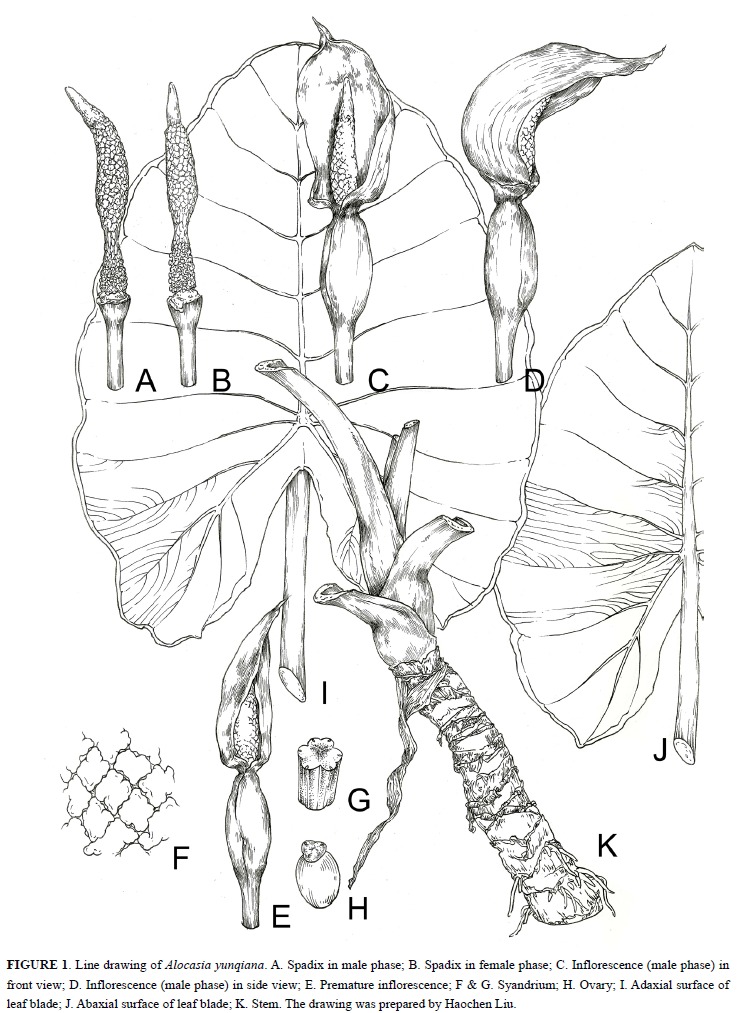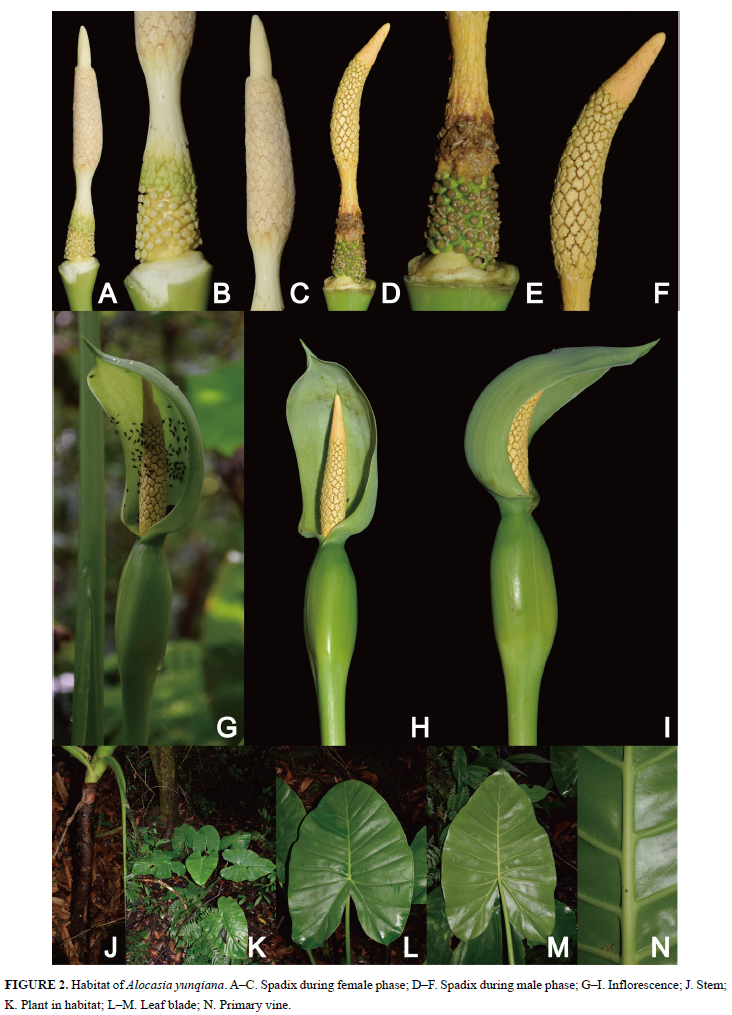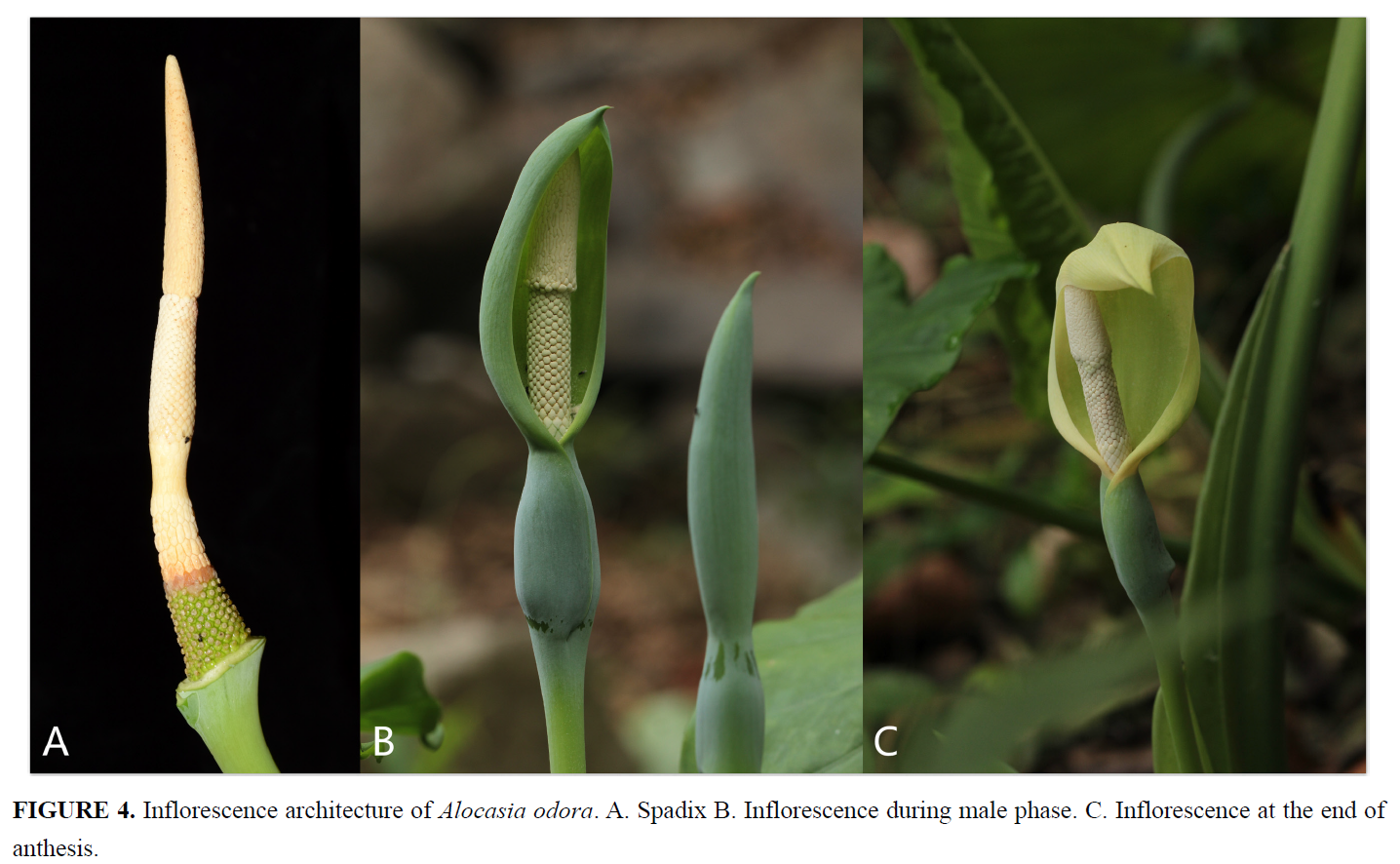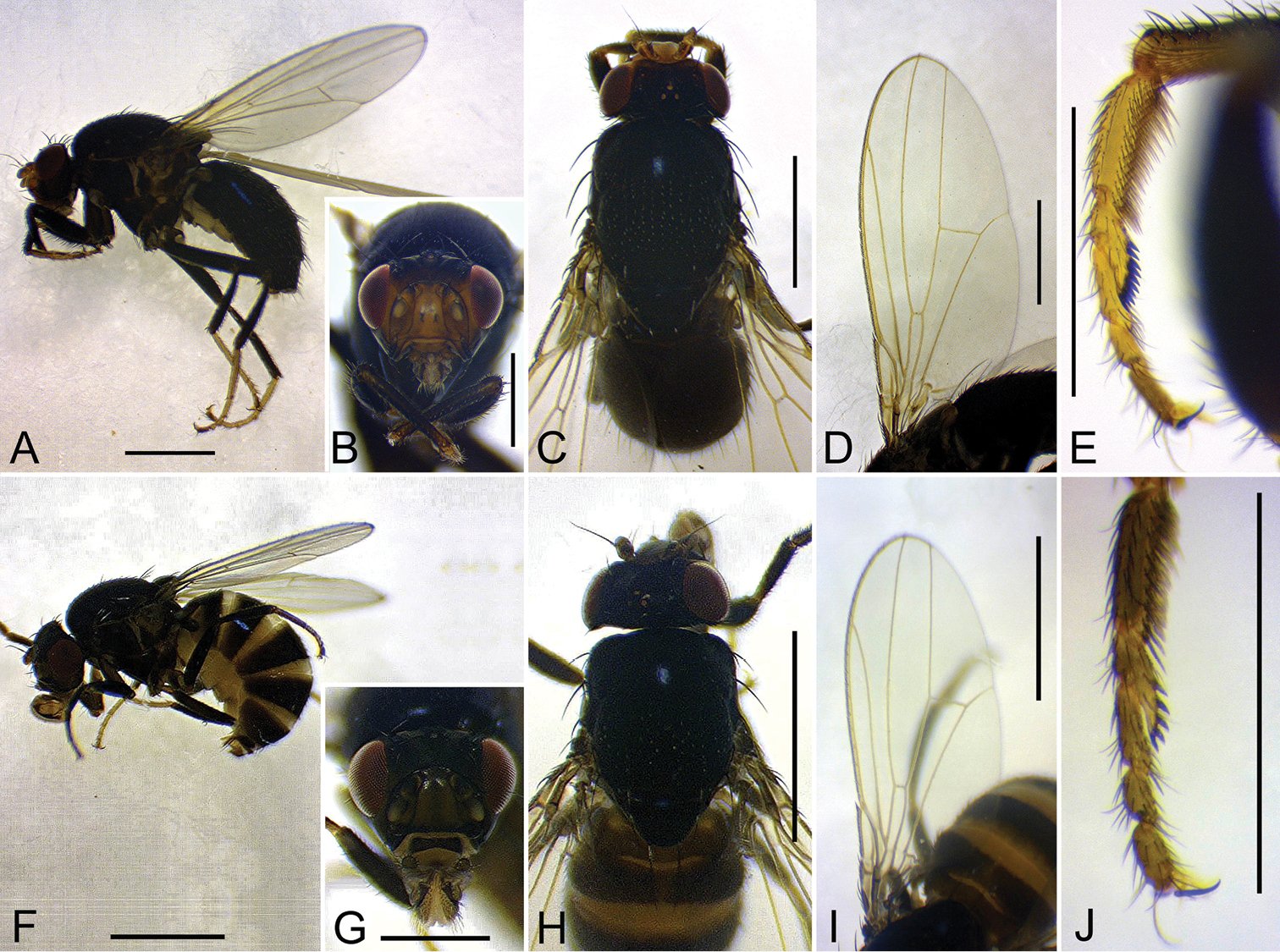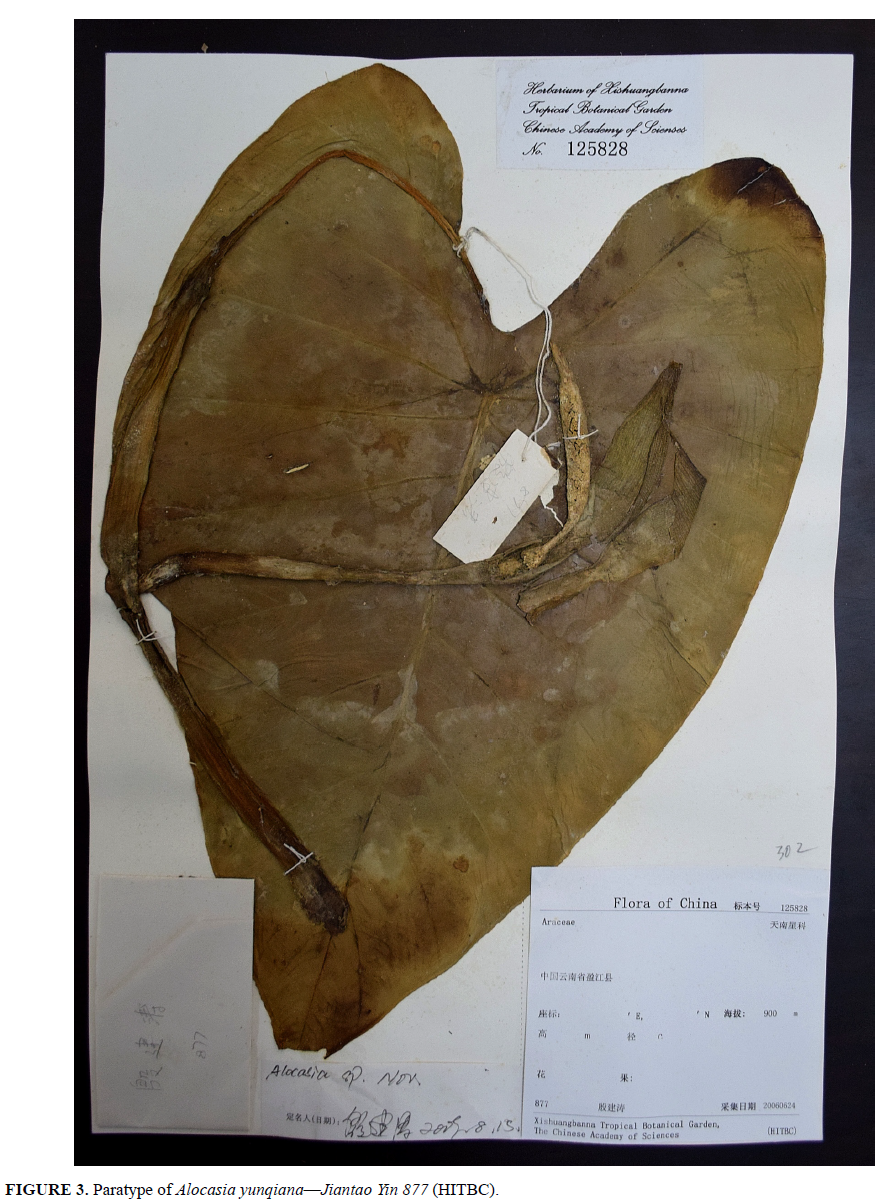ALOCASIA YUNQIANA
ORIGINAL DESCRIPTION:
This species resembles Alocasia odora (Roxburgh 1822: 641) Spach (1846: 46) but differs in having a strongly hooded and slightly glaucous to glossy spathe, a spadix with dimorphic synandroidia (elongated rhombic-hexagonal and irregular), a sterile interstice ca. ½ as long and more slender than the staminate zone and a conical spadix-appendix that is much shorter and thinner than the staminate zone, to 1.5 cm in length and tapering to the apex.
Type:—CHINA: Yunnan Province, Dehong Dai and Jingpo Autonomous Prefecture, Yingjiang County, Tongbiguan Township, Tongbiguan Nature Reserve, from on the road (S318) from Eerganya (而干亚) to Lekan (勒坎), elev. 1510 m, 7 June 2019, Yifan Li & Zhengxu Ma 142 (holotype PE!, isotype A!).
SYNONYMS: N/A
DISTRIBUTION: China | Yunnan province (Tongbiguan Nature Reserve). Also expected to be discovered in the adjacent regions including Myanmar.
CLIMATE: Subtropical humid climate
Humidity is moderate throughout the year, ranging from 60% to 70%
Temperature is varies between the seasons - within the range of 48°F/9°C to 88°F/31°C during the day. Minimum temperatures never dip below 45°F/7°C
Rainy and humid season (October to May) and a dry season between June and October. The average annual rainfall is 1,200 mm
ECOLOGY: Often observed in the rainforest or along the roadsides (elevations of 900+ m)
SPECIES DESCRIPTION:
Massive, pachycaul herb to ca. 2.0 m. Stem erect to decumbent, branchless; stolon unobserved. Leaves several to many clustering at the tip of the stem; petiole to 1.0 m in length; petiolar cataphyll thick membranous, greenish; leaf blade peltate, cordate-sagittate to cordate-ovate, to 120–100 cm, dull green and yellowish green when dried, smooth, glossy on both sides, apex short acuminate; primary lateral veins 9–12 on each side; interprimary veins forming well-defined interprimary collecting veins
INFLORESCENCE:
1–3 together, arising from leaf axil, sheathing into membranous cataphylls; peduncle cylindrical, to 65.0 cm in length, green; spathe to 25.0 cm in length, dividing into tube and limb by a constriction, slightly glaucous to glossy during anthesis; spath-tube ellipsoid, bright green; spathe-limb oblong-naviculiform-shaped, incurved, 20.0–25.0 cm in length, green, hooded and distinctly constricted at base, shortly acuminate at apex; spadix subtended by the spathe, short-stipitate; pistillate zone 1.0–2.0 × ca. 1.5 cm, cylindrical; ovaries yellowish green when mature; stigma sessile, obscurely 3-lobed, whitish yellow; sterile interstice narrowed to the apex corresponding to the spathe constriction, 2.0–3.0 in length, 0.7–1.2 cm diam. at construction, ca. 1/2 as long and and thinner than the staminate zone; synandroidia dimorphic, irregularly shaped at proximal sterile interstice, greenish during female phase and providing food sources for larva of pollinators after male phase, elongated rhombic-hexagonal, white at distil sterile interstice; staminate zone sub-cylindrical to barrel-shaped, slightly swollen midway, 4.5–6.0 × 2.0–2.7 cm, ivory to light yellow; synandria rhombo-hexagonal, convex-topped due to cap-forming synconnective; appendix short-conical, to 1.5 cm in length, much shorter and thinner than the staminate zone, ivory to light yellow.
Inflorescences produced from June to early July. Infructescences are unknown.
VARIEGATED FORMS: N/A
ETYMOLOGY: The epithet of the new species “ yunqiana” is derived from the Chinese word “运气” which means “luck”, to honour the Luck Art Festival (运气艺术节) organized by Hangzhou Lucky Cultural and Creative Industry Co. Ltd. for funding this study. The vernacular name in Chinese is recommended as “运气海芋”.
NOTES:
The morphological characteristics of Alocasia yunqiana are reminiscent of several species also distributed in continental Asia, including Alocasia cucullata (Loureiro 1790: 536) Don (1839: 631), Alocasia macrorrhizos (Linnaeus 1753: 965) G.Don in Sweet (1839: 631) and Alocasia odora (Roxburgh in Edwards 1822: 641) Spach (1846: 46), especially for their similar vegetative structures including an erect to decumbent stem and peltate, cordate-sagittate or cordateovate leaf blades.
However, differences between their inflorescence are readily recognizable and some issues on the differentiation of the inflorescence structure in Alocasia yunqiana and its relationship with its closely allied species Alocasia odora are worth to discuss herein. The spadix architecture in Alocasia yunqiana is distinct from Alocasia odora. Comparing to latter, whose spadix-appendix is subequal to the spadix but markedly thicker than the staminate zone at the base (Fig. 4 A) Alocasia yunqiana has a spadixappendix and sterile interstice that are much thinner and shorter than the staminate zone, and, in contrast, its staminate zone is subcylindrical and thickened in the middle (Fig. 2 A–F). Besides, it is also interesting to take notice of the dimorphism in the architecture of the synandroidia which implies the differentiation in function in Alocasia yunqiana (Fig. 2 A&E). Unlike synandroidia of Alocasia odora, synandroidia in Alocasia yunqiana are differentiated into two clusters: 1) green and irregular synandroidia at the basal part of sterile interstice, and 2) ivory, elongated rhombic-hexagonal-shaped in the rest of the region (Fig. 2 B). Combining with our empirical observation on its pollination process, the structural differentiation in synandroidia is related to the diversification of function in the sterile interstice of Alocasia yunqiana.
Furthermore, Alocasia yunqiana also differs from Alocasia odora in having a slightly glaucous spathe, and a strongly hooded, oblong-naviculiform limb of the spathe. The heavily glaucous exterior spathe surface is one of the most apparent characteristics for Alocasia odora and this trait endures during its entire anthesis. On the contrary, Alocasia yunqiana is only represented by a slightly glaucous to glossy spathe. In addition, the characteristics of spathe-limb also well defines Alocasia yunqiana, since spathe-limb of the former is oblong-boat-shaped and often recurved while the latter is thinner, and oblong-lanceolate. Accordingly, related to the spathe-limb structure, the constriction that separates spathe-limb and spathe-tube is very distinct in Alocasia yunqiana compared with Alocasia odora, and this structure is often related to the so-called “hooding” characteristics presented at the base of spathe-limb. The hooded spathe only appears at the end of the anthesis of Alocasia odora (Fig. 4 C), while Alocasia yunqiana tends to present this trait as early as the premature inflorescence (Fig. 1 E, Fig. 2 G–I).
2. The pollinator of Alocasia yunqiana has been preliminarily identified as Colocasiomyia aff. xenalocasiae, which is readily distinguishable from the typical Colocasiomyia xenalocasiae, a major pollinator reported from Alocasia odora (Okada 1975) by its much larger body size. However, DNA barcoding-based-studies are still required for further confirmation on its identity (personal correspondence with Qicheng Yang and Jianjun Gao). Besides, according to our observations in the field, the lower synandroidia of the sterile staminate spadix are likely to become the food source for the larva of its pollinators after the female phase. Similar phenomena have also been observed in Alocasia odora, but the synandroidia structure is not specialized to accommodate with the food demand of Colocasiomyia larva. Nevertheless, further studies are still required to ellucidate the relationships between the dimorphism in synandroidia and its impact on the behavior of pollinator
CULTIVARS: N/A
HYBRIDS: N/A



